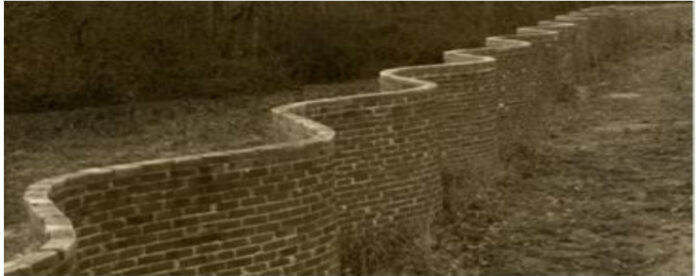We all know that civil engineering is a world of innovation. There are a lot of advancements in technology in today’s era. But most of the techniques that we use today in construction of many great structures are inspired from the ancient world. For example, the shinbashira(a central pillar) of ancient japanese Pagoda structure is the inspiration for the central tower used in Tokyo skytree.
Walls are an important component for any structure built. Now we are going to know about one of the innovative ancient wall structures called Wavy walls. Wavy wall also known as crinkle crankle wall or serpentine wall or sinusoidal wall. As the name indicates these walls are in the shape of waves( an alternate concave and convex curve ). They are popular in European nations like England from the 18th century, not only just because of their beautiful aesthetics but also because of many structural uses.
History of wavy walls:
These kinds of walls are mostly seen in various parts of the United Kingdom; we can see them as garden walls and compound walls in many of the historical structures of England. Especially in the county called Suffolk (East Anglian county of ancient origin in England), we can find around 50 of such kinds of walls belonging to the mid 1600s. It is believed that the word “crinkle crankle” is derived from suffolk’s dialect. Thomas Jefferson, the third president of the United States, incorporated these serpentine walls into the architecture of the University of Virginia. Some claim that these walls are designed by Thomas Jefferson with inspiration from the original English style.

But recent archaeological studies found these kinds of walls used in an ancient city of Egypt named “The Rise of Aten ” discovered under the sand on the western bank of Luxer, which is thought to be about 3500 years old. They found that the walls are around 10 feet high and made of mud bricks.
Benefits over straight walls:
When we see Wavy walls, we might think that they use more bricks but they use fewer bricks compared to the traditional straight walls as these walls are made with single brick thickness. In traditional straight compound walls we use multiple layers of bricks to maintain the stability of the wall. If we use a single layer of bricks in a straight wall, it will collapse easily. But the alternate convex and concave shape of the wavy wall helps the wall to stand still even with less thickness/ single layer. These walls are also more resistant towards the lateral forces like wind pressure and other outward forces, thanks to the sinusoidal shape and arch support.
People in England built these walls from east to west in their gardens so that one side is always under sun rays.
In terms of long compound walls and garden walls, use of crinkle crankle walls reduces the overall construction cost as they use less construction material. They are more durable for 100s of years and also improves the aesthetics of the structure.

Blog author details:
GRANDHE VISHNU PRATHAP
3rd YEAR ,CIVIL ENGINEERING.SSN COLLEGE OF ENGINEERING, CHENNAI.
MAIL ID: grandhe018@civil.ssn.edu.in
Info and Image Sources: cnn.com, en.m.wikipedia.org, faculty.med.virginia.edu, mymodernmet.com

